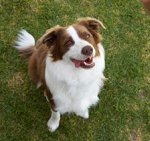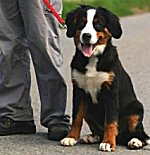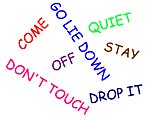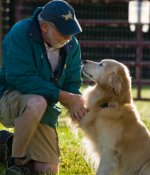Irish Terriers: What's Good About 'Em, What's Bad About 'Em
Irish Terrier temperament, personality, training, behavior, pros and cons, advice, and information, by Michele Welton, Dog Trainer, Behavioral Consultant, Author of 15 Dog Books
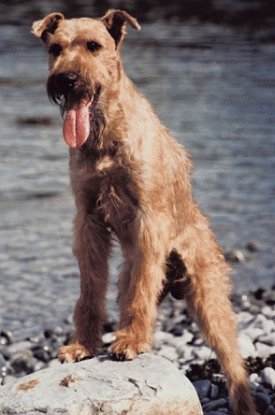
The AKC Standard says, "There is a heedless, reckless pluck about the Irish Terrier which...coupled with the headlong dash, blind to all consequences, with which he rushes at his adversary, has earned for the breed the proud epithet of Daredevil."
One of the boldest and most animated of the terriers, this fearless breed, built on lines of speed with a graceful, racy outline, must often be protected from himself.
Energetic and intense, he romps and plays with vigor and will take as much exercise as you can offer. Leashes and secure fences are compulsory, for he is exceedingly fast and agile, with strong chasing, digging, and jumping instincts.
The Irish Terrier does best with active families, for without exercise and lots of companionship and personal interaction, he will become bored and seek to entertain himself – and his choices usually involve mischief and destructiveness.
His reaction to strangers varies from polite to aloof, and even the polite ones are vigilant watchdogs. Early socialization is important for a stable, controlled temperament.
The Irish Terrier can be exceedingly scrappy with other animals, whether canine or feline, and will make short shrift of rabbits and rodents.
Stubborn and self-assured, he is inclined to test for position in the family pecking order.
If you want a dog who...
- Is medium-sized, with a slender, elegant build
- Doesn't shed too much (shed hairs are trapped in his wiry coat until you brush them out)
- Moves swiftly with light-footed grace
- Is one of the boldest of the terriers
- Thrives on vigorous athletic activities
- Makes a keen watchdog, yet is usually dependable with people
An Irish Terrier may be right for you.
If you don't want to deal with...
- The dynamic terrier temperament (see full description below)
- Providing enough exercise and activities to keep them busy
- Aggression toward other animals – chasing instincts
- Stubbornness
- Digging holes
- Barking
- Coat care: requires regular clipping
- Waiting lists (hard to find) and high price tag
An Irish Terrier may not be right for you.
 |
Dog Breed Traits – Which Traits Are Right For You? In this brand new series, I'll help you decide which dog breed traits would best suit you and your family, your home and yard, and your lifestyle, so you can choose the best dog breed for your family. |
Keep in mind that the inheritance of temperament is less predictable than the inheritance of physical traits such as size or shedding. Temperament and behavior are also shaped by raising and training.
FREE eBooks by Michele Welton
![]() "Respect Training for Puppies" and "Teach Your Dog 100 English Words" are free step by step guides to teaching your pup to be calm and well-behaved.
"Respect Training for Puppies" and "Teach Your Dog 100 English Words" are free step by step guides to teaching your pup to be calm and well-behaved.
![]() "11 Things You Must Do Right To Keep Your Dog Healthy and Happy" is a free guide to keeping your dog mentally, physically, and emotionally happy and healthy so you can enjoy a longer lifetime of companionship.
"11 Things You Must Do Right To Keep Your Dog Healthy and Happy" is a free guide to keeping your dog mentally, physically, and emotionally happy and healthy so you can enjoy a longer lifetime of companionship.

More traits and characteristics of the Irish Terrier
If I was considering an Irish Terrier, I would be most concerned about...
- The dynamic terrier temperament. Most terrier breeds are remarkably similar. The same words are used over and over – quick to bark, quick to chase, lively, bossy, feisty, scrappy, clever, independent, stubborn, persistent, impulsive, intense.
Irish Terriers are active go-getters. They require a fenced yard, plenty of companionship throughout the day, and regular opportunities to do interesting things (games and activities). But terriers should not be trusted off-leash. They will take off after anything that runs.
- Potential animal aggression. Most Irish Terriers are dominant or aggressive toward other dogs. Most have strong instincts to chase and seize small fleeing creatures. This can make for conflict if you own a cat. It may be much worse than that if you own a pet rabbit or hamster!
- Fence security. Many terriers are clever escape artists who will go over or under fences in search of adventure. Irish Terriers are athletic jumpers; you need higher fences than you might imagine for their size. You may also need to sink wire into the ground along the fence line to thwart digging.
- Potential barking. Terriers are often too quick to sound the alarm at every new sight and sound. You have to be equally quick to stop them. But that can be difficult unless you have established the right relationship with your Irish Terrier, where you are the leader and he is the follower.
Irish Terriers must be taught at an early age that they are not the rulers of the world. The toughness that makes them suited to killing vermin can frustrate you when you try to teach them anything. Terriers can be stubborn and dominant and will make you prove that you can make them do things. You must show them, through absolute consistency, that you mean what you say. Follow my free online training programs.
- Defensive reactions. If you need to physically chastise a terrier, and you go beyond what THEY believe is a fair correction, terriers (as a group) are more likely than other breeds to growl or snap. As an obedience instructor, I'm always extra careful when putting my hands on any terrier for a correction.
I do not recommend Irish Terriers around small children. Many terriers will not tolerate any nonsense from little life forms whom they consider to be below themselves in importance. Many terriers are quick to react to teasing, and even to the normal clumsiness that comes with small children (accidental squeezing of their ears or pulling of whiskers or stepping on their paw). Many terriers are possessive of their food and toys and will defend these from all comers.
- Lots of coat care. Irish Terriers require clipping and trimming every few months. Breed purists may say that terrier coats should never be clipped because it makes the coat softer and more prone to matting. Instead they advocate hand-stripping (each dead hair pulled out so a new one can grow in its place). But in my opinion, stripping is too time-consuming and uncomfortable for the dog. Many groomers won't do it anymore. For pet dogs, I think clipping is just fine.
- Finding one. In the United States, very few Irish Terrier puppies are born each year. You'll probably need to go on a waiting list.
My best-selling books – now available FREE on my website
 Respect Training For Puppies: 30 seconds to a calm, polite, well-behaved puppy is for puppies 2 to 18 months old. Your puppy will learn the 21 skills that all family dogs need to know. Click here to read for free.
Respect Training For Puppies: 30 seconds to a calm, polite, well-behaved puppy is for puppies 2 to 18 months old. Your puppy will learn the 21 skills that all family dogs need to know. Click here to read for free. Teach Your Dog 100 English Words is a unique Vocabulary and Respect Training Program that will teach your adult dog to listen to you and do what you say. Click here to read for free.
Teach Your Dog 100 English Words is a unique Vocabulary and Respect Training Program that will teach your adult dog to listen to you and do what you say. Click here to read for free. 11 Things You Must Do Right To Keep Your Dog Healthy and Happy helps your dog live a longer, healthier life. Get my honest advice about all 11 Things before you bring home your new puppy, because some mistakes with early health care cannot be undone. Click here to read for free.
11 Things You Must Do Right To Keep Your Dog Healthy and Happy helps your dog live a longer, healthier life. Get my honest advice about all 11 Things before you bring home your new puppy, because some mistakes with early health care cannot be undone. Click here to read for free.Related posts you might enjoy



